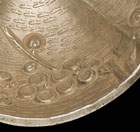J.J. Lally & Co., Oriental Art / New York City, New York
MenuPast Exhibition
Silver and Gold in Ancient China
March 16 – April 14, 2012
27.
A REPOUSSÉ-DECORATED SILVER ‘PLUM BLOSSOM’ CUP
Southern Song Dynasty (A.D. 1127-1279)
with steeply rounded sides divided into five lobes by deep grooves on the exterior and with corresponding raised ribs on the interior converging on a five-petal plum blossom in relief in the center, also decorated in repoussé on the interior with a blossoming plum branch extending down from the rim to fill one side opposite a crescent moon beside wispy clouds on the other side, the interior ground punched with repeating rows of linear open-oval motifs to indicate water, as if the moon and prunus branch were reflected on the rippling surface of a lake, the design shown in reverse on the unfinished exterior, the cup raised on a separately made thick disc-shaped foot soldered onto the base, with a square-edged footring enclosing a recessed base engraved with four characters: wu shen fu zhi (戊申甫置), the plain band below the lip rim indistinctly stamped with four indecipherable characters on the exterior, possibly indicating the maker or the location of manufacture, the surface lightly tarnished and showing traces of earth from burial.
Diameter 3 5⁄8 inches (9.2 cm)
The two characters wu shen incised on the base, from the table of characters used to indicate the year in the traditional sixty-year cyclical dating system, but without inclusion of a reign title or emperor’s name, provide an incomplete cyclical date. This cup can be securely attributed to the Southern Song dynasty on the basis of stylistic and other criteria, and therefore the most likely date represented by these two characters is A.D. 1188 or A.D. 1248.
Compare the flower-shaped silver bowl with plum blossom design excavated in 1971 from the tomb of a couple deceased in A.D. 1195 and A.D. 1199 respectively according to the epitaph in the tomb in Jiangpu county near Nanjing, Jiangsu province, illustrated in Wenwu, 1973, No. 4, p. 65, fig. 16.
A flower-shaped gilt-silver bowl with matching saucer decorated in repoussé with the same ‘moon and prunus’ motif, unearthed from a cache at Gu county, Fujian province, now in the collection of Shaowu City Museum, is illustrated in the catalogue of the special exhibition entitled Dynastic Renaissance: Art and Culture of the Southern Song—Antiquities, Taipei, 2010, p. 183, no. III-58.
Another Song dynasty silver bowl of five-petal flower shape with a raised flower in the center and further embellished with leaves and engraved blossoming branches picked out in gilding, in the Tokyo National Museum, is illustrated by Nishida and Tahira (eds.) in the catalogue of an exhibition at the Nezu Institute of Fine Arts entitled Sōgen no bi: denrai no shikki o chūshin ni (The Colors and Forms of Song and Yuan China – Featuring Lacquerwares, Ceramics and Metalwares), Tokyo, 2004, no. 8.
Compare also the Southern Song Longquan celadon-glazed stoneware bowl incised with a ‘moon and prunus’ motif on the interior, from the Bernat Collection, illustrated by Wirgin in ‘Sung Ceramic Designs,’ B.M.F.E.A., Bulletin no. 42, Stockholm, 1970, pl. 38b.
南宋 梅月紋花口銀盞 徑 9.2 厘米
